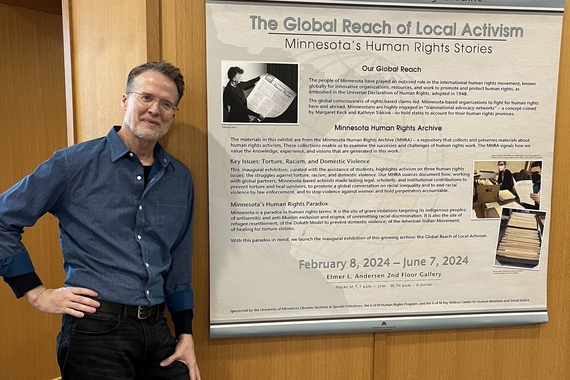Press Reporting on Disappearance Cases in Mexico
The Observatory on Disappearances and Impunity in Mexico is an international academic and advocacy collaborative established in 2015 to investigate, analyze, and combat patterns of impunity regarding enforced disappearances in Mexico. Its three principal investigators, HRP Director Barbara Frey, Professor Leigh Payne of Oxford University, and Professor Karina Ansolabehere of the Institute for Legal Research (IIJ-UNAM) and the Latin American Faculty of Social Sciences (FLACSO-Mexico) have been working with undergraduate students, graduate students and alumni to explain disappearances in México as a means to bring an end to this terrible pattern of human rights violations.
This spring the Human Rights Program will be publishing a comprehensive web-based report and database discussing the UMN-based team's component of the project. The virtual launch of this website and the Human Rights Program’s findings will take place on Thursday, April 22, 2021 at 12:00 Central Time. Leading up to the report release, we feature a three-part series of blog posts written by key members of the Observatory team, originally posted to Observatorio Sobre Desaparición E Impunidad En México in Spanish and English. This first blog installment by Barbara Frey covers analyzing press reports. The English version is being reposted here with permission from the Institute for Legal Research at UNAM and FLACSO-México.
Press Reporting on Disappearance Cases
(originally posted 11/24/2020)
The Human Rights Program at the University of Minnesota compiled a database of more than 1600 press articles on disappearance cases in the states of Coahuila, Guerrero, Jalisco, and Nuevo León, from 2009 to mid-2018. From this collection of press reports, we sought to learn what information was available to the public about the crimes, the victims, the perpetrators, and the justice system in disappearance cases. Our study complements other work of the Observatory, including an analysis of data from nongovernmental organizations in the states of Nuevo León, Coahuila y Tamaulipas.
Reasons for our study
The media play an important role in the investigation and public denunciation of human rights violations, as well as agenda-setting for institutional reform and reparations. Journalists can promote “social accountability” by (1) shaming public officials responsible for human rights violations and (2) activating state institutions, such as the courts (Peruzzotti and Smulovitz 2006:12). The media act as a mechanism of human rights accountability not only by activating public institutions but also by serving as a platform for debate in particular cases.
Previous studies have shown that the print media has been particularly important in shaping public opinion by increasing political knowledge and mobilizing citizen action (Scheufele, Shanahan and Kim 2002). A cross-national study found that a nation’s level of newspaper readership positively affected human rights outcomes (Clark 2012).
This literature demonstrates that the media itself can play a “watchdog” role in human rights accountability. The bottom line is that, if human rights violations are not reported, if the press does not exercise its role as a watchdog, then citizens do not have the information they need to contest the violations.
Methods and their limitations
Our student team at the University of Minnesota located Mexican press articles through keyword searches using variations of the Spanish roots for “disappearance” and “kidnapping” and “levanton.” We only included stories about named victims because we wanted to understand how the press represented specific cases. We coded the articles to capture the news source, data about the victim, the event, the perpetrator, and the state’s response.
There are limitations to this method of gathering data, which is subject to the whims of Google and other search engines. These difficulties illustrated for us that fundamental investigative dilemma about disappearances -- evidence often vanishes along with the person.
The press database
Despite these limits, the press reports we collected yielded important information. We chose four states for our study, Coahuila, Nuevo Leon, Guerrero, and Jalisco, because they had high levels of disappearances and we understood their local contexts from our previous work. We identified press reports for 651 disappearance cases published online by 227 press outlets during the nine year span. To prevent an unbalance in the press database, we chose to exclude press reports from two highly publicized cases -- the case of the 43 students disappeared in Ayotzinapa, in 2014, and the case of three film students in Guadalajara, Jalisco, in 2018.
The number of articles published about each named victim in our database spanned from 1 to 23 articles. In 24% of the 651 reported cases, the press published only one article about the case. The median number published per case was three articles. Large numbers of articles about a single disappearance case, generated by investigative reporting or follow up, were rare. The most highly reported disappearances -- those with the most articles written about them -- tended to be about cases relating to family or group disappearances, to public figures, or to highly sympathetic victims such as small children.
The state with the highest number of disappearance cases reported by the press between 2009 and mid-2018 was Coahuila, with a total of 196 cases. There were 173 cases reported in Jalisco and 162 cases in Nuevo Leon. The state with the fewest reported cases was Guerrero, with 120.
Key findings
Two key findings emerged regarding the nature of these press reports on disappearances:
• The press typically reported on each disappearance case as a single criminal event and not as an ongoing human rights violation, and
• the press in these states did not carry out its “watchdog” function of following up on the state’s response to the disappearances.
Reporting the “nota roja”
Press articles on disappearances tended to be published in the crime section of the newspaper, as a “nota roja” (crime report). Reporters did not demonstrate expertise on the disappearance crisis in Mexico. Instead, they were often assigned crime stories on a rotating basis, depending on who was in the newsroom. Our database has stories from 482 individual reporters (covering 651 cases). For security reasons, articles about organized crime in disappearance cases were frequently published as “staff reporting.” At least 55% of the cases included at least one “staff reported” article.
In most articles, the information about the case was limited to basic demographic information on the victim (e.g. gender, age, occupation), facts about the disappearance (e.g. location, date, municipality) and, in about 41% of the reported cases, the suspected perpetrator.
Journalistic expertise in disappearance cases grew as the crisis grew and, by the mid-2010s, several individual reporters and news collectives, such as “A Donde Van los Desaparecidos,” and “ZonaDocs”, began to publish extraordinary and in-depth investigations into these crimes. Unfortunately, their work was the exception.
Lack of follow up
Our database demonstrated that journalists seldom wrote follow up stories about disappearance cases. In 89% of cases, the press did not report whether a court process had been initiated for the disappearance. The press reported a court case in only 10% of the disappearances, a total of 62 out of the 651 cases across the four states. In 36 of those cases, the press explained that a sentence had been delivered, and in 10 cases they reported a sentence in process; however, only in 18 cases did the press specify the type of sentence.
The lack of reporting meant that the media did not push state institutions, such as prosecutors or courts, to achieve justice in these cases. The press did not fulfill its role as a watchdog and, thus, the public did not have information it needed to demand accountability for these crimes.
Watch for the full results of our study at https://cla.umn.edu/human-rights/engagement/mexicoprojects.
References
Clark, Rob, “Bringing the Media in: Newspaper Readership and Human Rights,” Sociological Inquiry, November 2012, Vol.82(4), 532-556.
Peruzzotti, Enrique and Catalina Smulovitz, eds., Enforcing the Rule of Law: Social Accountability and the New Latin American Democracies, (Pittsburgh: U Pittsburgh Press, 2006).
Principal Investigator Observatorio de Desaparición e Impunidad. Senior Lecturer and Director, Human Rights Program, Institute for Global Studies, University of Minnesota.
Scheufele, Dietram A., James Shanahan and Sei-Hill Kim, “Who Cares about Local Politics? Media Influences on Local Political Involvement, Issue Awareness, and Attitude Strength,” Journalism & Mass Communication Quarterly, Vol.79(2), 2002, 427-444



